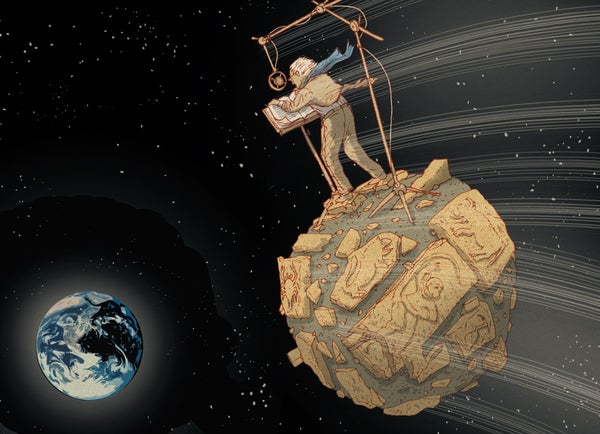Graham Hancock is an audacious autodidact who believes that long before ancient Mesopotamia, Babylonia and Egypt there existed an even more glorious civilization. One so thoroughly wiped out by a comet strike around 12,000 years ago that nearly all evidence of its existence vanished, leaving only the faintest of traces, including, Hancock thinks, a cryptic warning that such a celestial catastrophe could happen to us. All this is woven into a narrative entitled Magicians of the Gods (Thomas Dunne Books, 2015). I listened to the audio edition read by the author, whose British accent and breathless, revelatory storytelling style are confessedly compelling. But is it true? I'm skeptical.
First, no matter how devastating an extraterrestrial impact might be, are we to believe that after centuries of flourishing every last tool, potsherd, article of clothing, and, presumably from an advanced civilization, writing, metallurgy and other technologies—not to mention trash—was erased? Inconceivable.
Second, Hancock's impact hypothesis comes from scientists who first proposed it in 2007 as an explanation for the North American megafaunal extinction around that time and has been the subject of vigorous scientific debate. It has not fared well. In addition to the lack of any impact craters determined to have occurred around that time anywhere in the world, the radiocarbon dates of the layer of carbon, soot, charcoal, nanodiamonds, microspherules and iridium, asserted to have been the result of this catastrophic event, vary widely before and after the megafaunal extinction, anywhere from 14,000 to 10,000 years ago. Further, although 37 mammal genera went extinct in North America (while most other species survived and flourished), at the same time 52 mammal genera went extinct in South America, presumably not caused by the impact. These extinctions, in fact, were timed with human arrival, thereby supporting the more widely accepted overhunting hypothesis.
On supporting science journalism
If you're enjoying this article, consider supporting our award-winning journalism by subscribing. By purchasing a subscription you are helping to ensure the future of impactful stories about the discoveries and ideas shaping our world today.
Third, Hancock grounds his case primarily in the argument from ignorance (because scientists cannot explain X, then Y is a legitimate theory) or the argument from personal incredulity (because I cannot explain X, then my Y theory is valid). This is the type of “God of the gaps” reasoning that creationists employ, only in Hancock's case the gods are the “magicians” who brought us civilization. The problem here is twofold: (1) scientists do have good explanations for Hancock's X's (for example, the pyramids, the Great Sphinx), even if they are not in total agreement, and (2) ultimately one's theory must rest on positive evidence in favor of it, not just negative evidence against accepted theories.
Hancock's biggest X is Göbekli Tepe in Turkey, with its megalithic, T-shaped seven- to 10-ton stone pillars cut and hauled from limestone quarries and dated to around 11,000 years ago, when humans lived as hunter-gatherers without, presumably, the know-how, skills and labor to produce them. Ergo, Hancock concludes, “at the very least it would mean that some as yet unknown and unidentified people somewhere in the world, had already mastered all the arts and attributes of a high civilization more than twelve thousand years ago in the depths of the last Ice Age and had sent out emissaries around the world to spread the benefits of their knowledge.” This sounds romantic, but it is the bigotry of low expectations. Who is to say what hunter-gatherers are or are not capable of doing? Plus, Göbekli Tepe was a ceremonial religious site, not a city—there is no evidence that anyone lived there. Moreover, there are no domesticated animal bones, no metal tools, no inscriptions or writing, and not even pottery—all products that much later “high civilizations” produced.
Fourth, Hancock has spent decades in his vision quest to find the sages who brought us civilization. Yet decades of searching have failed to produce enough evidence to convince archaeologists that the standard timeline of human history needs major revision. Hancock's plaint is that mainstream science is stuck in a uniformitarian model of slow, gradual change and so cannot accept a catastrophic explanation.
Not true. From the origin of the universe (big bang), to the origin of the moon (big collision), to the origin of lunar craters (meteor strikes), to the demise of the dinosaurs (asteroid impact), to the numerous sudden downfalls of civilizations documented by Jared Diamond in his 2005 book Collapse, catastrophism is alive and well in mainstream science. The real magicians are the scientists who have worked this all out.
